A Ghost Railroad. Colorado, with its history of rich mining operations, left the state with not only quaint ghost towns, but also some historic ghost railroads. After an adventurous and authentic restoration, the Georgetown Loop Railroad has been transformed into a passenger tourist railroad.
Georgetown is a Victorian town in Colorado’s Clear Creek Canyon where high surrounding mountains display old silver mine tailings.
Originally conceived to carry silver ore in 1865, it began as the Colorado & Clear Creek Railroad. Its tracks would eventually extend some 60 miles to Denver.
A mere two miles from Georgetown’s Devils Gate Station, but 650 feet lower in altitude, is the Silver Plume Station. Between the two lies the present-day restored remnant of the old rail system.
Originally, surveyors concluded that laying straight track to connect these two stations would require an impractical 6.5% grade. The corkscrew route which they eventually hammered out was 4.5 miles long, and averaged a steep (but manageable) 3.5% grade.
| |
|
|
| |
|
|
| |
A black diesel switcher, built in 1948 by Porter Locomotive Works of Pittsburgh, gets ready to hook up to our train. |
|
The price of silver plummeted in the Panic of 1893, and mining slowed. Passenger revenue kept the line operating, as it became a popular scenic route. Ownership was transferred to the Colorado and Southern Railway until 1938 when the route was abandoned and the tracks pulled up.
The Saga of the Restoration—or Stone Soup.
Thirty-some years later, what is now called The Georgetown Loop Railroad was rescued by the Colorado Historical Society. Their first bold step was to persuade the state’s Department of Transportation not to build Interstate Highway I-70 over the old railroad grade. The Interstate was then rerouted along the base of Republican Mountain.
Remember the old story of the man who started to make “stone soup” with just a kettle of boiling water and a rock? His neighbors then contributed carrots, potatoes, and meat. In a similar way, this project started to bubble once serious plans were in place. Sources of help came from everywhere, including, of all places, the U.S. Navy.
The Denver and Rio Grande Railroad chipped in with five narrow-gauge passenger cars. The Loveland Ski Associates, who by that time were owners of the Silver Plume Depot, donated it. Other equipment came, by barge and flatcars, from Alaska’s Yukon and White Pass Railroad.
| |
|
|
|
|
| |
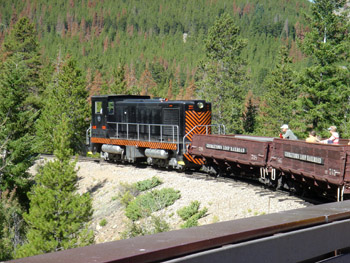 |
|
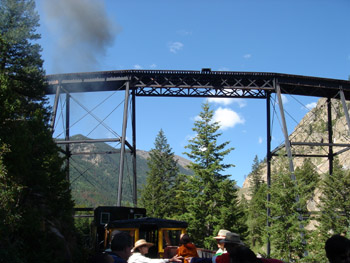 |
|
| |
On a balmy August day, riders enjoy the open air cars of the Georgetown Loop. |
|
The train winds through narrow Clear Creek Canyon under the bridge which crosses over its own tracks. |
|
A construction crew serendipitously arrived from a very unlikely source—again, the U.S. Navy to the rescue. Its Reserve Mobile Construction Battalion (Seabees) just happened to be planning a training exercise—to build a railroad. The Historical Society was happy to provide them with the opportunity and the location.
Union Pacific Railroad offered to contribute several miles of their railroad track, lying unused on an abandoned spur.The Seabees pulled up the tracks, hauled them to Silver Plume, and re-laid them. Et voilà—The Georgetown Loop Railroad.
We ride the Train out of Devil’s Gate Station. The railroad’s ex-Colorado & Southern # 9 steam engine, a vintage 1884 2-6-0, is not pulling the train today. It’s inside the Engine House and its smoke box is off. We peek in as a repairman squats inside the boiler, his acetylene torch generating showers of orange sparks.
| |
|
|
|
|
| |
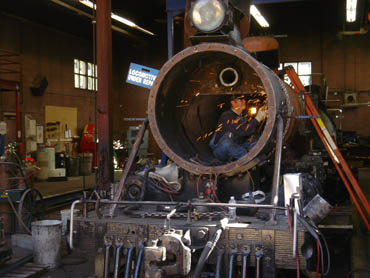 |
|
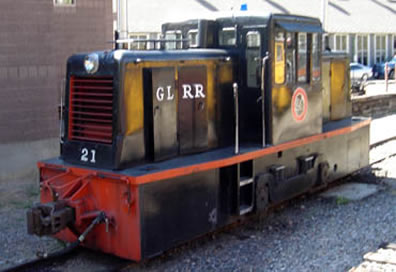 |
|
| |
Locomotive Under Repair: Georgetown Loop's steam engine gets a going over; an unstreamlined diesel will pull the train. |
|
Georgetown Loop's narrow-gauge switch engine prepares to hook onto the train. |
|
With an elephantine bleat of the air-horn, an un-streamlined black diesel switcher, built in 1948, couples to the rear of the train. While regular enclosed cars with coach seats and glass windows are used in cool weather, we’re blessed with June's balmy summer air. Thus today, the consist includes open gondola cars interspersed with wooden cars. The latter are jury-rigged with metal roofs and open-air sides.
Pushing out of the Devil’s Gate Station, which has a well-stocked gift shop, the train enters a forest of pines and aspens. Clear Creek cascades steeply beside the tracks and we cross it on several trestles. Cuts and fills have been built using “dry-stacked” rocks carefully fitted together without mortar, like a jigsaw puzzle.
The old Lebanon Silver Mine, in its own effort to help the resurrected railroad succeed, has reopened for tours. Passengers may detrain at the Lebanon Mine Station, don hard-hats, and visit the operation of the mine the railroad was originally built to serve. An extra cost option, this requires walking underground for ¾ of a mile at a 42 degree temperature. We elect to stay on board.
Soon the train passes a cascading waterfall, and then a work train (one scooter car with a trailer) equipped for some track work, before winding under the dramatically high bridge. This is the most often photographed part of the line.
| |
|
|
|
|
| |
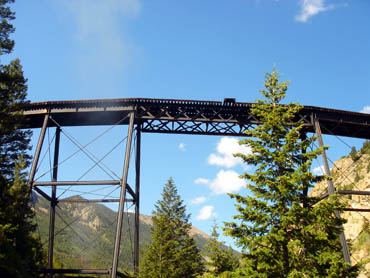 |
|
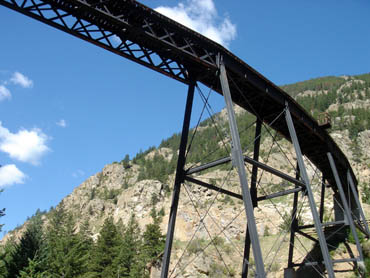 |
|
| |
The 3.5% grade between the two stations requires the narrow-gauge tracks to loop over themselves to gain elevation. |
|
The original 95-foot high bridge was taken down when the railroad stopped operating in 1938. A million dollar grant from the Boettcher Foundation paid for duplicating the original curved High Bridge in 1973. |
|
In 1883, the original 300-foot long bridge span was built in Pennsylvania. Then, section by section, it was shipped west on flat cars. The 95-foot high bridge enabled the track to loop over itself, but was taken down when the original railroad stopped operating. A million dollar grant from the Boettcher Foundation paid for duplicating the original High Bridge in 1973.
The train has some aspects of an amusement park ride, offering a short trip popular with kids and their grandparents. It is actually trademarked as The Georgetown Loop Historic Mining & Railroad Park.
Our turn-around point, Silver Plume Station, lies in a deep gorge with huge mine tailings piled among the trees. (Passengers may board at either of the stations.) After we arrive, the engine runs around the train and pulls us along the three-foot, narrow-gauge tracks, and over the Devil’s Gate Bridge. Here passengers have a bird’s eye view of the tracks below, on which they traveled earlier, and a look at the top of the bridge, with its curved, six-foot elevation gain from one side to the other.
This historic, short stretch of track furnishes non-stop scenery surrounded by mountains.
| |
|
|
| |
|
|
| |
A black diesel switcher, built in 1948 by Porter Locomotive Works of Pittsburgh |
|
The Georgetown Loop Railroad may be reached by writing to P.O. Box 217, 111 Rose Street, Georgetown, Colorado, 80444. Telephone is 1 303 569 2403, or 1 800 691 4386.
Besides contacting the railroad directly, another option for reserving your tickets is on The Georgetown Loop Railroad Deluxe Tour. It features from-and-to-your-door van service, a photo stop at 11,990-foot Loveland Pass, plus free sunscreen and bottled water. A round trip on the railroad, including the Lebanon Mine tour, is followed by an hour in which to explore Georgetown. The tour includes more extras—a picnic lunch at Clear Lake and a drive over Mt. Bierstadt with its waterfalls and wildlife, a visit to the Canyon Wind Winery, and complimentary ice cream cones.
For the tour package, as well as adventures on other tourist railroads in the area, please contact Alpenglow Adventures Train Tours at 970 468 7777 or alpenglowadventurestours.com.
Sylvia Blishak can be reached at: sylvia@traintravelconsulting.com
NAMED ONE OF THE WORLD'S TOP TRAVEL SPECIALISTS BY CONDE NAST TRAVELER MAGAZINE SINCE 2002.
3939 S. Sixth St. #331, Klamath Falls, OR 97603 Phone: 800 347 0645 Fax: 541 883 6457 |

